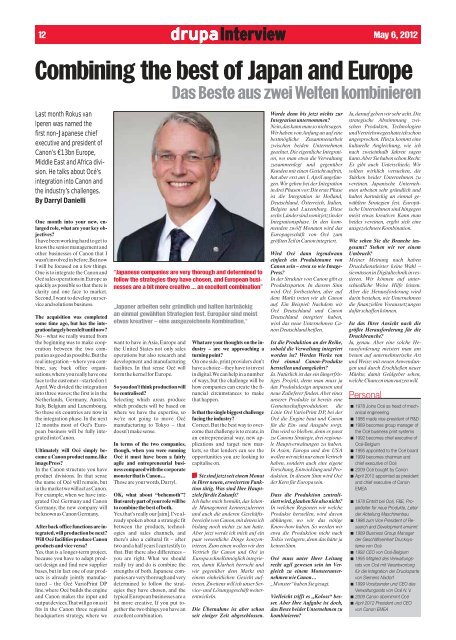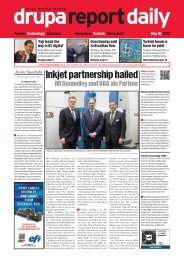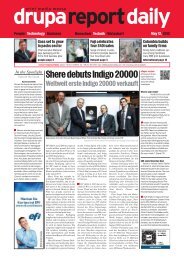drd 2012-05-06 - Drupa Report Daily
drd 2012-05-06 - Drupa Report Daily
drd 2012-05-06 - Drupa Report Daily
Erfolgreiche ePaper selbst erstellen
Machen Sie aus Ihren PDF Publikationen ein blätterbares Flipbook mit unserer einzigartigen Google optimierten e-Paper Software.
drupa Interview<br />
12 May 6, <strong>2012</strong><br />
Combining the best of Japan and Europe<br />
Last month Rokus van<br />
Iperen was named the<br />
first non-Japanese chief<br />
executive and president of<br />
Canon’s €13bn Europe,<br />
Middle East and Africa division.<br />
He talks about Océ’s<br />
integration into Canon and<br />
the industry’s challenges.<br />
By Darryl Danielli<br />
One month into your new, enlarged<br />
role, what are your key objectives?<br />
I have been working hard to get to<br />
know the senior management and<br />
other businesses of Canon that I<br />
wasn’t involved in before. But now<br />
I will be focused on a few things.<br />
One is to integrate the Canon and<br />
Océ sales operations in Europe as<br />
quickly as possible so that there is<br />
clarity and one face to market.<br />
Second, I want to develop our service<br />
and solutions business.<br />
The acquisition was completed<br />
some time ago, but has the integration<br />
largely been left until now?<br />
No – what we really wanted from<br />
the beginning was to make cooperation<br />
between the two companies<br />
as good as possible. But the<br />
real integration – where you combine,<br />
say, back office organisations,<br />
where you really have one<br />
face to the customer – started on 1<br />
April. We divided the integration<br />
into three waves; the first is in the<br />
Netherlands, Germany, Austria,<br />
Italy, Belgium and Luxembourg.<br />
So those six countries are now in<br />
the integration phase. In the next<br />
12 months most of Océ’s European<br />
business will be fully integrated<br />
into Canon.<br />
Ultimately will Océ simply become<br />
a Canon product name, like<br />
imagePress?<br />
In the Canon structure you have<br />
product divisions. In that sense<br />
the name of Océ will remain, but<br />
in the market we will act as Canon.<br />
For example, when we have integrated<br />
Océ Germany and Canon<br />
Germany, the new company will<br />
be known as Canon Germany.<br />
After back office functions are integrated,<br />
will production be next?<br />
Will Océ facilities produce Canon<br />
products and vice versa?<br />
Yes, that is a longer-term project,<br />
because you have to adapt product<br />
design and find new supplier<br />
bases, but in fact one of our products<br />
is already jointly manufactured<br />
– the Océ VarioPrint DP<br />
line, where Océ builds the engine<br />
and Canon makes the input and<br />
output devices. That will go on as it<br />
fits in the Canon three regional<br />
headquarters strategy, where we<br />
“Japanese companies are very thorough and determined to<br />
follow the strategies they have chosen, and European businesses<br />
are a bit more creative ... an excellent combination”<br />
want to have in Asia, Europe and<br />
the United States not only sales<br />
operations but also research and<br />
development and manufacturing<br />
facilities. In that sense Océ will<br />
form the kernel for Europe.<br />
So you don’t think production will<br />
be centralised?<br />
Selecting which areas produce<br />
which products will be based on<br />
where we have the expertise, so<br />
we’re not going to move Océ<br />
manufacturing to Tokyo – that<br />
doesn’t make sense.<br />
In terms of the two companies,<br />
though, when you were running<br />
Océ it must have been a fairly<br />
agile and entrepreneurial business<br />
compared with the corporate<br />
monster that is Canon…<br />
Those are your words, Darryl.<br />
OK, what about “behemoth”?<br />
But surely part of your role will be<br />
to combine the best of both.<br />
Yes, that’s really our [aim]. I’ve already<br />
spoken about a strategic fit<br />
between the products, technologies<br />
and sales channels, and<br />
there’s also a cultural fit – after<br />
two and a half years I can testify to<br />
that. But there also differences –<br />
you are right. What we should<br />
really try and do is combine the<br />
strengths of both. Japanese companies<br />
are very thorough and very<br />
determined to follow the strategies<br />
they have chosen, and the<br />
typical European businesses are a<br />
bit more creative. If you put together<br />
the two things, you have an<br />
excellent combination.<br />
Das Beste aus zwei Welten kombinieren<br />
„Japaner arbeiten sehr gründlich und halten hartnäckig<br />
an einmal gewählten Strategien fest. Europäer sind meist<br />
etwas kreativer – eine ausgezeichnete Kombination.“<br />
What are your thoughts on the industry<br />
– are we approaching a<br />
turning point?<br />
On one side, print providers don’t<br />
have a choice – they have to invest<br />
in digital. We can help in a number<br />
of ways, but the challenge will be<br />
how companies can create the financial<br />
circumstances to make<br />
that happen.<br />
Is that the single biggest challenge<br />
facing the industry?<br />
Correct. But the best way to overcome<br />
that challenge is to create, in<br />
an entrepreneurial way, new applications<br />
and target new markets,<br />
so that lenders can see the<br />
opportunities you are looking to<br />
capitalise on.<br />
Sie sind jetzt seit einem Monat<br />
in Ihrer neuen, erweiterten Funktion<br />
tätig. Was sind Ihre Hauptziele<br />
für die Zukunft?<br />
Ich habe mich bemüht, das leitende<br />
Management kennenzulernen<br />
und auch die anderen Geschäftsbereiche<br />
von Canon, mit denen ich<br />
bislang noch nichts zu tun hatte.<br />
Aber jetzt werde ich mich auf ein<br />
paar wesentliche Dinge konzentrieren.<br />
Zum einen wollen wir den<br />
Vertrieb für Canon und Océ in<br />
Europa schnellstmöglich integrieren,<br />
damit Klarheit herrscht und<br />
wir gegenüber dem Markt mit<br />
einem einheitlichen Gesicht auftreten.<br />
Zweitens will ich unser Service-<br />
und Lösungsgeschäft weiterentwickeln.<br />
Die Übernahme ist aber schon<br />
seit einiger Zeit abgeschlossen.<br />
Wurde denn bis jetzt nichts zur<br />
Integration unternommen?<br />
Nein, das kann man so nicht sagen.<br />
Wir haben von Anfang an auf eine<br />
bestmögliche Zusammenarbeit<br />
zwischen beiden Unternehmen<br />
geachtet. Die eigentliche Integration,<br />
wo man etwa die Verwaltung<br />
zusammenlegt und gegenüber<br />
Kunden mit einen Gesicht auftritt,<br />
hat aber erst am 1. April angefangen.<br />
Wir gehen bei der Integration<br />
in drei Phasen vor: Die erste Phase<br />
ist die Integration in Holland,<br />
Deutschland, Österreich, Italien,<br />
Belgien und Luxemburg. Diese<br />
sechs Länder sind somit jetzt in der<br />
Integrationsphase. In den kommenden<br />
zwölf Monaten wird das<br />
Europageschäft von Océ zum<br />
größten Teil in Canon integriert.<br />
Wird Océ dann irgendwann<br />
einfach ein Produktname von<br />
Canon sein – etwa so wie Image-<br />
Press?<br />
In der Struktur von Canon gibt es<br />
Produktsparten. In diesem Sinn<br />
wird Océ fortbestehen, aber auf<br />
dem Markt treten wir als Canon<br />
auf. Ein Beispiel: Nachdem wir<br />
Océ Deutschland und Canon<br />
Deutschland integriert haben,<br />
wird das neue Unternehmen Canon<br />
Deutschland heißen.<br />
Ist die Produktion an der Reihe,<br />
sobald die Verwaltung integriert<br />
worden ist? Werden Werke von<br />
Océ einmal Canon-Produkte<br />
herstellen und umgekehrt?<br />
Ja. Natürlich ist das ein längerfristiges<br />
Projekt, denn man muss ja<br />
das Produktdesign anpassen und<br />
neue Zulieferer finden. Aber eines<br />
unserer Produkte ist bereits eine<br />
Gemeinschaftsproduktion: die<br />
Linie Océ VarioPrint DP, bei der<br />
Océ die Engine baut und Canon<br />
für die Ein- und Ausgabe sorgt.<br />
Das wird so bleiben, denn es passt<br />
zu Canons Strategie, drei regionale<br />
Hauptverwaltungen zu haben.<br />
In Asien, Europa und den USA<br />
wollen wir nicht nur einen Vertrieb<br />
haben, sondern auch eine eigene<br />
Forschung, Entwicklung und Produktion.<br />
In diesem Sinn wird Océ<br />
der Kern für Europa sein.<br />
Dass die Produktion zentralisiert<br />
wird, glauben Sie also nicht?<br />
In welchen Regionen wir welche<br />
Produkte herstellen, wird davon<br />
abhängen, wo wir das nötige<br />
Know-how haben. So werden wir<br />
etwa die Produktion nicht nach<br />
Tokio verlagern, denn das hätte ja<br />
keinen Sinn.<br />
Océ muss unter Ihrer Leitung<br />
recht agil gewesen sein im Vergleich<br />
zu einem Monsterunternehmen<br />
wie Canon ...<br />
„Monster“ haben Sie gesagt.<br />
Vielleicht trifft es „Koloss“ besser.<br />
Aber Ihre Aufgabe ist doch,<br />
das Beste beider Unternehmen zu<br />
kombinieren?<br />
Ja, darauf geben wir sehr acht. Die<br />
strategische Abstimmung zwischen<br />
Produkten, Technologien<br />
und Vertriebswegen hatte ich schon<br />
angesprochen. Hinzu kommt eine<br />
kulturelle Angleichung, wie ich<br />
nach zweieinhalb Jahren sagen<br />
kann. Aber Sie haben schon Recht:<br />
Es gibt auch Unterschiede. Wir<br />
sollten wirklich versuchen, die<br />
Stärken beider Unternehmen zu<br />
vereinen. Japanische Unternehmen<br />
arbeiten sehr gründlich und<br />
halten hartnäckig an einmal gewählten<br />
Strategien fest. Europä -<br />
ische Unternehmen sind hingegen<br />
meist etwas kreativer. Kann man<br />
beides vereinen, ergibt sich eine<br />
ausgezeichnete Kombination.<br />
Wie sehen Sie die Branche ins -<br />
gesamt? Stehen wir vor einem<br />
Umbruch?<br />
Meiner Meinung nach haben<br />
Druckdienstleister keine Wahl –<br />
sie müssen in Digitaltechnik investieren.<br />
Wir können auf unterschiedliche<br />
Weise Hilfe leisten.<br />
Aber die Herausforderung wird<br />
darin bestehen, wie Unternehmen<br />
die finanziellen Voraussetzungen<br />
dafür schaffen können.<br />
Ist das Ihrer Ansicht nach die<br />
größte Herausforderung für die<br />
Druckbranche?<br />
Ja, genau. Aber eine solche Herausforderung<br />
meistert man am<br />
besten auf unternehmerische Art<br />
und Weise: mit neuen Anwendungen<br />
und durch Erschließen neuer<br />
Märkte, damit Geldgeber sehen,<br />
welche Chancen man nutzen will.<br />
Personal<br />
■ 1978 Joins Océ as head of mechanical<br />
engineering<br />
■ 1986 made vice-president of R&D<br />
■ 1989 becomes group manager of<br />
the Océ business print systems<br />
■ 1992 becomes chief executive of<br />
Océ-Belgium<br />
■ 1995 appointed to the Océ board<br />
■ 1999 becomes chairman and<br />
chief executive of Océ<br />
■ 2009 Océ bought by Canon<br />
■ April <strong>2012</strong> appointed as president<br />
and chief executive of Canon<br />
EMEA<br />
■ 1978 Eintritt bei Océ, F&E, Projektleiter<br />
für neue Produkte, Leiter<br />
der Abteilung Maschinenbau<br />
■ 1986 zum Vice President of Research<br />
and Development ernannt<br />
■ 1989 Business Group Manager<br />
der Geschäftseinheit Drucksys -<br />
teme von Océ<br />
■ 1992 CEO von Océ-Belgium<br />
■ 1995 Mitglied des Verwaltungsrats<br />
von Océ mit Verantwortung<br />
für die Integration der Drucksparte<br />
von Siemens Nixdorf<br />
■ 1999 Vorsitzender und CEO des<br />
Verwaltungsrats von Océ N. V.<br />
■ 2009 Canon übernimmt Océ<br />
■ April <strong>2012</strong> President und CEO<br />
von Canon EMEA






